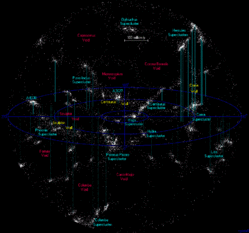Still working to recover. Please don't edit quite yet.
Difference between revisions of "supercluster"
(New page: __NOTOC__{{Cleanup|date=November 2006}} Virgo) Superclusters]] :''See Supercluster (genetic) for u...) |
m (robot Removing: de, fi, he, hr, ja, nl, pl, pt, ru, sv, zh) |
||
| Line 82: | Line 82: | ||
[[ca:Grans estructures galà ctiques]] | [[ca:Grans estructures galà ctiques]] | ||
| − | |||
[[es:Supercúmulo]] | [[es:Supercúmulo]] | ||
[[fr:Superamas]] | [[fr:Superamas]] | ||
| − | |||
[[io:Globatra grupo]] | [[io:Globatra grupo]] | ||
[[it:Superammasso di galassie]] | [[it:Superammasso di galassie]] | ||
| − | |||
| − | |||
| − | |||
| − | |||
| − | |||
| − | |||
| − | |||
| − | |||
[[vi:Siêu thiên hà ]] | [[vi:Siêu thiên hà ]] | ||
| − | |||
Revision as of 17:47, 18 September 2008

- See Supercluster (genetic) for use of the word in genetics.
Superclusters are large groupings of smaller galaxy groups and clusters, and are among the largest structures of the cosmos. The existence of superclusters indicates that the galaxies in our Universe are not uniformly distributed; most of them are drawn together in groups and clusters, with groups containing up to 50 galaxies and clusters up to several thousand. Those groups and clusters and additional isolated galaxies in turn form even larger structures called superclusters.
Once thought to be the largest structures in nature, superclusters are now understood to be subordinate to enormous walls or sheets, sometimes called "super cluster complexes", that can span a billion light-years in length, more than 5% of the observable universe. Super clusters themselves can span several hundred million light-years. The typical speed of a galaxy is about 1000 km/s. Hubble's law implies that typical galaxies would only move about 30 million light-years at that speed in a Hubble time of 1/H, which is approximately the age of the universe. While this is a huge distance in human terms, it is much smaller than the size of super clusters. In an expanding universe, saying that the distance d an object has moved equals its present velocity v times the elapsed time t underestimates d when t is not small compared to 1/H. The calculation above still gives some idea of how long it would take the normal movements of galaxies to form or obliterate these structures, and thus indicates their great age. When we observe super clusters and larger structures today, we learn about the condition of the universe when these super clusters were created. The directions of the rotational axes of galaxies within super clusters also gives us insight into the formation process of galaxies early in the history of the Universe.[1]
No clusters of super clusters (“hyperclustersâ€) are known, and the existence of structures larger than superclusters is debated (see Galaxy filament). Interspersed among super clusters are large voids of space in which few galaxies exist. Even though superclusters are the largest structures confirmed, the total number of superclusters leaves possibilities for structural distribution; the total number of super clusters in the universe is believed to be close to 10 million.
Super clusters are frequently subdivided into groups of clusters called galaxy clouds.
Nearby superclusters
- Local Supercluster: contains the Local Group with our galaxy, the Milky Way. It also contains the Virgo cluster near its center, and is sometimes called the Virgo Supercluster.
- Hydra-Centaurus Supercluster
- Hydra Supercluster
- Centaurus Supercluster
- Perseus-Pisces Supercluster
- Pavo-Indus Supercluster
- Coma Supercluster
- Phoenix Supercluster
- Sculptor Superclusters
- Hercules Superclusters
- Leo Supercluster
- Shapley Supercluster
- Sloan Great Wall
Distant Superclusters
- Pisces-Cetus Supercluster
- Bootes Supercluster
- Horologium Supercluster
- Corona Borealis Supercluster
- Columba Supercluster
- Aquarius Supercluster
- Aquarius B Supercluster
- Aquarius-Capricornus Supercluster
- Aquarius-Cetus Supercluster
- Bootes A Supercluster
- Caelum Supercluster
- Draco Supercluster
- Draco-Ursa Majoris Supercluster
- Fornax-Eridanus Supercluster
- Grus Supercluster
- Leo A Supercluster
- Leo-Sextans Supercluster
- Leo-Virgo Supercluster
- Microscopium Supercluster
- Pegasus-Pisces Supercluster
- Pisces Supercluster
- Pisces-Aries Supercluster
- Ursa Majoris Supercluster
- Virgo Coma Supercluster
See also
External links
References
- ↑ Hu, F. X.; Wu, G. X.; Song, G. X.; Yuan, Q. R.; Okamura, S., (2006). "Orientation of Galaxies in the Local Supercluster: A Review," Astrophysics and Space Science, 302, 43-59.